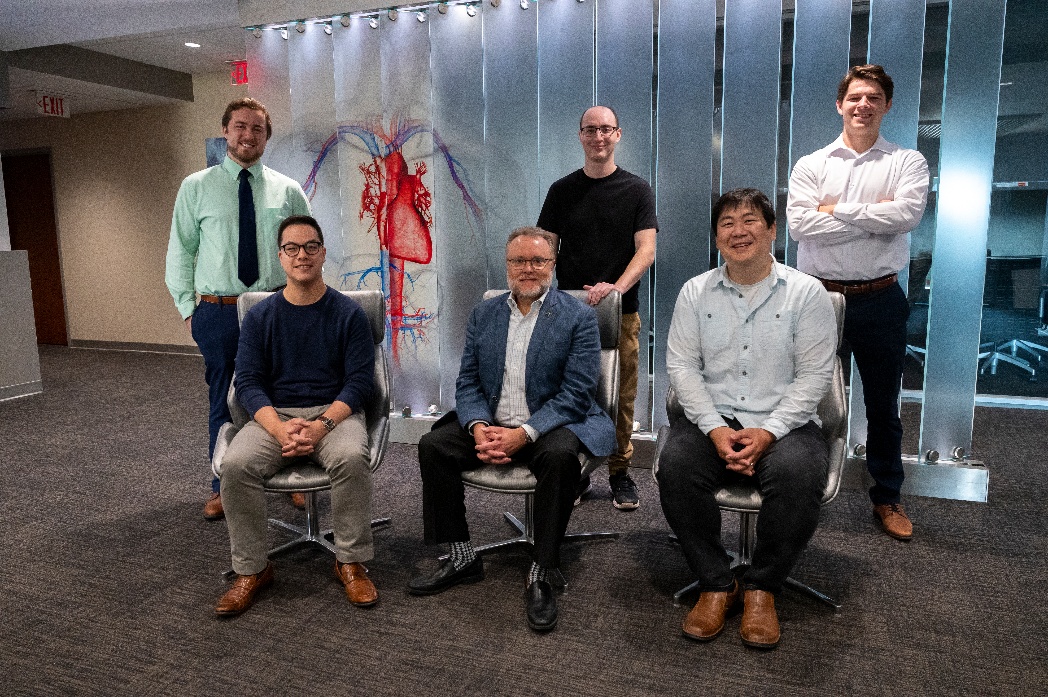Abdominal aortic aneurysm (AAA) affects upwards of 2.5 million people in the US. Clinical management of AAA remains challenging as many aneurysms will rupture before reaching the minimum criteria for treatment. Using clinical, biomechanical, and shape data, the University of Pittsburgh Aneurisk innovation team has developed a clinical decision support tool to score the risk of aneurysm rupture to better manage patient outcomes. With the insight gained through their participation in the NSF I-Corps program, the Aneurisk team has sharpened its go-to-market strategy and has been accepted into one of the region's premiere life science incubator programs.

The Aneurisk team is (seated from left to right) assistant professor of surgery, Nathan Liang, senior assistant dean for research and facilities at the School of Engineering, David Vorp, and research assistant professor of bioengineering, Timothy Chung; (standing left to right) student Peter Bueldner, developer Chris Niles, and student Micah Guffey.
Aneurysm ruptures are costly and significantly increase risk for surgical repair. They are also deadly, with upwards of 40 percent mortality. AAA surveillance is expensive; the average per patient cost has been reported as $40,000 for four years. The tool analyzes medical images using artificial intelligence and has completed the most extensive study of its kind drawing from UPMC clinical data. While the Aneurisk team is focused now on AAA, these methodologies can be applied to other types of aneurysms and cardiovascular diseases.
After participating in the NSF I-Corps regional commercialization short course program, the multi-disciplinary team behind the Aneurisk clinical decision support tool came away with a better idea of how their innovation could add value for clinicians and their patients.
“As scientists and engineers, we are often blinded by our desire to develop novel approaches and techniques. The NSF National I-Corps program enabled our team to understand whether the market and potential stakeholders are even interested in our technology,” said Aneurisk co-founder Timothy Chung, research assistant professor in the Department of Bioengineering at the Swanson School of Engineering.
The project arose out of a collaboration between Chung, Nathan Liang, assistant professor of surgery at the Pitt School of Medicine and a vascular surgeon for UPMC, and David Vorp, Senior Associate Dean for Research & Facilities and the John A. Swanson Professor of Bioengineering, who has studied the disease for over 30 years. The team received an early-stage commercialization grant award of $300,000 from the Pittsburgh Health Data Alliance, and a $100,000 award from a collaboration between Pitt’s Institute for Precision Medicine and the Innovation Institute, with funding from a Richard King Mellon Foundation.
Innovation Institute entrepreneur in residence Dan Broderick highly recommended that the team continue its customer discovery journey by applying to the competitive NSF National I-Corps program, which they did successfully.
They were tasked to perform over 100 new interviews of potential stakeholders in a 7-week period to further hone the value proposition their innovation could deliver to those stakeholders, while also sharpening their go-to-market strategy. The National I-Corps team was comprised of an entrepreneurial lead, Micah Guffey a master’s bioengineering student, technical lead, Tim Chung, co-technical lead, Pete Gueldner, a PhD candidate in Bioengineering, and an industry mentor, Chris Niles, who has relevant experience building software packages for the greater Pittsburgh region.
The National I-Corps program provided the team a $50,000 stipend to assist with customer discovery efforts. With this funding the team visited founders of tech-companies in Silicon Valley, the Fogarty Innovation startup incubator, clinicians within the Stanford Health Care system, and attend a Stanford Graduate School of Business Healthcare Conference.
“In the National I-Corps program we talked to people in industry; people in utilization management within hospital systems; people involved in the reimbursement process; division chiefs,” said Micah Guffey, the student entrepreneurial lead for the team.
He added, “We came out of it with a better understanding of not only the clinical value proposition, but the clinical adoption system. Not just the end-user and their experience, but also the less-understood challenges of working within the hospital system. We came out with a more rounded vision of what it will take to get to market.”
Broderick, the entrepreneur in residence who has been working with the Aneurisk team for nearly two years, said they have made significant progress on the road to commercialization.
“The Aneurisk team has demonstrated a willingness to learn from the voice of the customer. They invested the time to determine if their potential customers have a clinical problem that their technology could solve and how their go-to-market strategy reflected their potential customers' concerns,” he said.
Moving forward, Broderick said he is eager for the Office of Innovation and Entrepreneurship to assist Aneurisk in obtaining investment and licensing the technology to take it into the world.
The Aneurisk team, having honed its investor pitch through its I-Corps participation, also won a $100,000 award in the Pitt Innovation Challenge (PInCh), hosted by the Clinical and Translational Sciences Institute (CTSI), in October.
If you have a Pitt innovation that may have potential to make an impact in the real world, you can begin your commercialization journey with a month-long NSF I-Corps short course. Learn more.